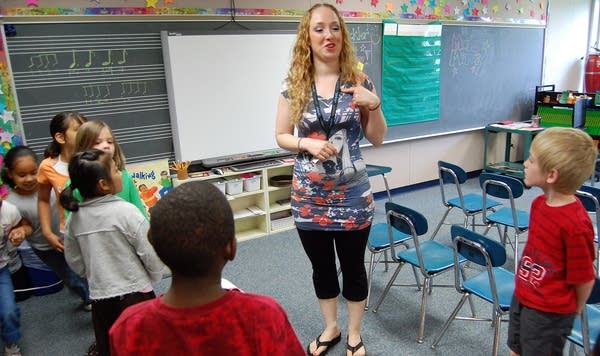Teachers anxious as job market tightens

It's a nerve-wracking time of year for out-of-work teachers in Minnesota.
Schools that lay off teachers in the spring usually hire some back in late summer as they get a better idea of how many students they'll have and how their budgets look. The prospect of even a few hires has applicants chomping at the bit. But school district officials say the job market has been especially tight for teachers.
Jana Meckler spent the spring teaching music to youngsters at Little Canada Elementary.
Before the school year ended, a normal day started with teaching youngsters the song they were to perform for the big year-end assembly.
Create a More Connected Minnesota
MPR News is your trusted resource for the news you need. With your support, MPR News brings accessible, courageous journalism and authentic conversation to everyone - free of paywalls and barriers. Your gift makes a difference.
A substitute teacher, mostly for Roseville schools, Meckler hopes to find a permanent job soon. She's applied for several music teaching jobs around the Twin Cities, but to no avail. Competition is fierce.
"At minimum, right now I would say there are probably 300 applicants for every opening," she said.
"Class sizes are going to go to levels we haven't seen in years and years."
The problem is Meckler is trying to become a teacher in a subject that state and local education officials say is saturated with candidates.
About 350 new teachers graduate from St. Cloud State University each year, and officials there wanted to know if the teachers they were producing are the teachers districts actually need. So the university surveyed school districts in the St. Cloud area.
It found that St. Cloud University is producing too many physical education, social studies, and elementary education teachers, said Dean Glen Palm, interim dean of the College of Education. Palm said the saturation was so drastic in elementary education that he wonders if changes are needed.
"There's a part of me that, ethically, would like to cap the program because we don't need to be turning out as many people," he said.
The idea that there would be too many candidates for teaching jobs contradicts warnings in recent years of a looming teacher shortage caused by the mass retirement of Baby Boomers. Palm doesn't question that Baby Boomers are aging -- he's one of them. But that retirement rush?
"We've heard it before, and it never materialized," he said.
The down economy has left older teachers unable to afford to retire, Palm said. The office that oversees teacher pensions in Minnesota confirms there have been fewer retirements than expected in each of the past four years, though it appears there was a slight uptick this year.
Meanwhile, districts are laying off teachers to balance their tight budgets. One survey estimated that all metro-area districts have laid off a combined 1,200 people this year.
When delayed retirements are combined with ongoing layoffs, the result is a greater number of applicants for each job opening.
That doesn't happen in every subject, though. Just as officials report saturated subject areas, they also report jobs they can't fill.
Larry Guggisberg, superintendent in Roseau, in far northern Minnesota, has trouble finding applicants because of his district's remote location. But the kind of teachers he needs also deters applicants.
"I have two special ed vacancies [and] I can't find people," he said.
As a result, Larry Guggisberg said he might have to seek state approval to hire someone who doesn't have the specific qualifications he's looking for.

Schools report an almost desperate shortage of licensed special education teachers. Other shortages are reported in math and certain sciences. St. Cloud State claims to produce as many teachers as any college in Minnesota, but it hasn't graduated a single physics teacher in three years.
Despite those shortage areas, the overall market remains tight, especially for teachers with less seniority and job security.
Dennis Carlson, superintendent of Anoka-Hennepin, the state's largest district, can map a sequence where he'd have to lay off 600 teachers in four years, depending on whether voters approve a referendum next year. Carlson said he's never seen the teacher situation so dire.
"It's not like we don't need them," Carlton said. "What's going to happen is class sizes are going to go to levels we haven't seen in years and years. I've heard some of the early numbers and I don't even want to say them publicly because they're just not areas we've seen before. And this is not just going to be Anoka-Hennepin."
Carlson's advice for new teachers just out of college: Have a plan B.
Jana Meckler does. When she's not teaching she and her husband play in a jazz trio called the Jana Nyberg Group (Nyberg is her maiden name). The group is currently on tour.
The question for Meckler is whether it's easier to break into teaching or jazz.
"Let's say jazz is easier because after a year and a half, we're kind of where we want to be at," she said. "Whereas, I still don't have a long-term contract, do I? I don't have a salary yet. The salaries I've had come to a gentle close."
The jazz tour ends in two weeks. Then the work really starts: trying to find teaching job for the fall.
